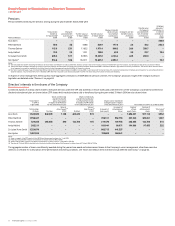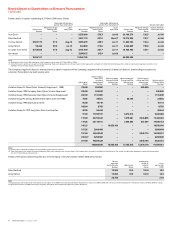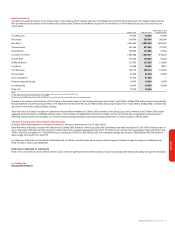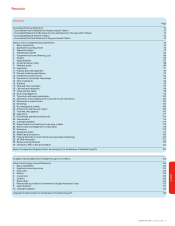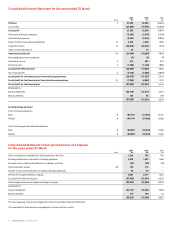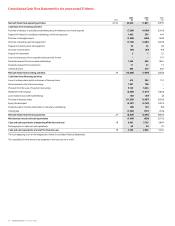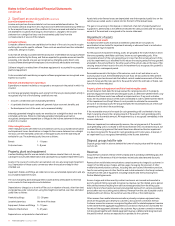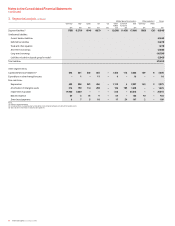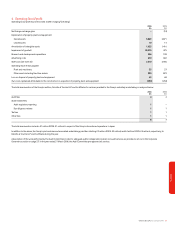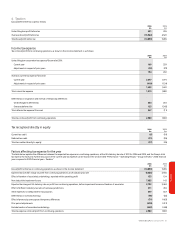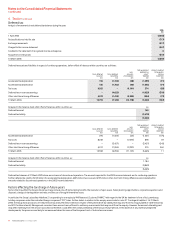Vodafone 2006 Annual Report Download - page 78
Download and view the complete annual report
Please find page 78 of the 2006 Vodafone annual report below. You can navigate through the pages in the report by either clicking on the pages listed below, or by using the keyword search tool below to find specific information within the annual report.
76 Vodafone Group Plc Annual Report 2006
Notes to the Consolidated Financial Statements
continued
Licence and spectrum fees
Licence and spectrum fees are stated at cost less accumulated amortisation. The
amortisation periods range from 3 to 25 years and are determined primarily by reference
to the unexpired licence period, the conditions for licence renewal and whether licences
are dependent on specific technologies. Amortisation is charged to the income
statement on a straight-line basis over the estimated useful lives from the
commencement of service of the network.
Computer software
Computer software licences are capitalised on the basis of the costs incurred to acquire
and bring into use the specific software. These costs are amortised over their estimated
useful lives, being 3 to 5 years.
Costs that are directly associated with the production of identifiable and unique software
products controlled by the Group, and that are expected to generate economic benefits
exceeding costs beyond one year, are recognised as intangible assets. Direct costs
include software development employee costs and directly attributable overheads.
Software integral to a related item of hardware equipment is accounted for as property,
plant and equipment.
Costs associated with maintaining computer software programmes are recognised as an
expense as incurred.
Research and development expenditure
Expenditure on research activities is recognised as an expense in the period in which it is
incurred.
An internally-generated intangible asset arising from the Group’s development activity is
recognised only if all of the following conditions are met:
•an asset is created that can be separately identified;
•it is probable that the asset created will generate future economic benefits; and
•the development cost of the asset can be measured reliably.
Internally-generated intangible assets are amortised on a straight-line basis over their
estimated useful lives. Where no internally-generated intangible asset can be
recognised, development expenditure is charged to the income statement in the period
in which it is incurred.
Other intangible assets
Other intangible assets with finite lives are stated at cost less accumulated amortisation
and impairment losses. Amortisation is charged to the income statement on a straight-
line basis over the estimated useful lives of intangible assets from the date they are
available for use. The estimated useful lives are as follows:
Brands 1 - 10 years
Customer bases 3 - 8 years
Property, plant and equipment
Land and buildings held for use are stated in the balance sheet at their cost, less any
subsequent accumulated depreciation and subsequent accumulated impairment losses.
Assets in the course of construction are carried at cost, less any recognised impairment
loss. Depreciation of these assets commences when the assets are ready for their
intended use.
Equipment, fixtures and fittings are stated at cost less accumulated depreciation and any
accumulated impairment losses.
The cost of property, plant and equipment includes directly attributable incremental
costs incurred in their acquisition and installation.
Depreciation is charged so as to write off the cost or valuation of assets, other than land
and properties under construction, using the straight-line method, over their estimated
useful lives as follows:
Freehold buildings 25 - 50 years
Leasehold premises the term of the lease
Equipment, fixtures and fittings 3 - 10 years
Network infrastructure 3 - 25 years
Depreciation is not provided on freehold land.
Assets held under finance leases are depreciated over their expected useful lives on the
same basis as owned assets or, where shorter, the term of the relevant lease.
The gain or loss arising on the disposal or retirement of an item of property, plant and
equipment is determined as the difference between the sales proceeds and the carrying
amount of the asset and is recognised in the income statement.
Impairment of assets
Indefinite lived assets
Goodwill and other assets that have an indefinite useful life are not subject to
amortisation but are tested for impairment annually or whenever there is an indication
that the asset may be impaired.
For the purpose of impairment testing, assets are grouped at the lowest levels for which
there are separately identifiable cash flows, known as cash-generating units. If the
recoverable amount of the cash-generating unit is less than the carrying amount of the
unit, the impairment loss is allocated first to reduce the carrying amount of any goodwill
allocated to the unit and then to the other assets of the unit pro-rata on the basis of the
carrying amount of each asset in the unit. An impairment loss recognised for goodwill is
not reversed in a subsequent period.
Recoverable amount is the higher of fair value less costs to sell and value in use. In
assessing value in use, the estimated future cash flows are discounted to their present
value using a pre-tax discount rate that reflects current market assessments of the time
value of money and the risks specific to the asset for which the estimates of future cash
flows have not been adjusted.
Property, plant and equipment and finite lived intangible assets
At each balance sheet date, the Group reviews the carrying amounts of its property,
plant and equipment and finite lived intangible assets to determine whether there is any
indication that those assets have suffered an impairment loss. If any such indication
exists, the recoverable amount of the asset is estimated in order to determine the extent
of the impairment loss (if any). Where it is not possible to estimate the recoverable
amount of an individual asset, the Group estimates the recoverable amount of the cash-
generating unit to which the asset belongs.
If the recoverable amount of an asset (or cash-generating unit) is estimated to be less
than its carrying amount, the carrying amount of the asset (or cash-generating unit) is
reduced to its recoverable amount. An impairment loss is recognised immediately in the
income statement.
Where an impairment loss subsequently reverses, the carrying amount of the asset (or
cash-generating unit) is increased to the revised estimate of its recoverable amount, not
to exceed the carrying amount that would have been determined had no impairment
loss been recognised for the asset (or cash-generating unit) in prior years. A reversal of
an impairment loss is recognised immediately in the income statement.
Disposal groups held for sale
Disposal groups held for sale are stated at the lower of carrying value and fair value less
costs to sell.
Revenue
Group revenue comprises revenue of the Company and its subsidiary undertakings plus the
Group’s share of the revenue of its joint ventures and excludes sales taxes and discounts.
Revenue from mobile telecommunications comprises amounts charged to customers in
respect of monthly access charges, airtime usage, messaging, the provision of other
mobile telecommunications services, including data services and information provision,
fees for connecting users of other fixed line and mobile networks to the Group’s network,
revenue from the sale of equipment, including handsets and revenue arising from
Partner Market Agreements.
Access charges and airtime used by contract customers are invoiced and recorded as
part of a periodic billing cycle and recognised as revenue over the related access period,
with unbilled revenue resulting from services already provided from the billing cycle
date to the end of each period accrued and unearned revenue from services provided in
periods after each accounting period deferred. Revenue from the sale of prepaid credit is
deferred until such time as the customer uses the airtime, or the credit expires.
Other revenue from mobile telecommunications primarily comprises equipment sales,
which are recognised upon delivery to customers, and customer connection revenue.
Customer connection revenue is recognised together with the related equipment revenue
to the extent that the aggregate equipment and connection revenue does not exceed the
fair value of the equipment delivered to the customer. Any customer connection revenue
not recognised together with related equipment revenue is deferred and recognised over
the period in which services are expected to be provided to the customer.
2. Significant accounting policies continued


